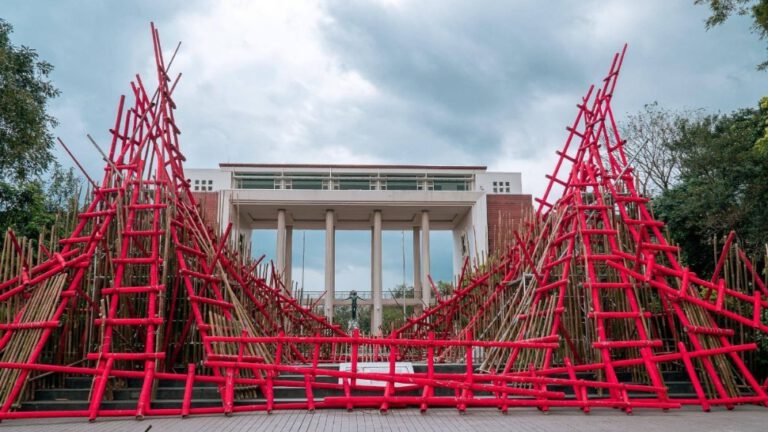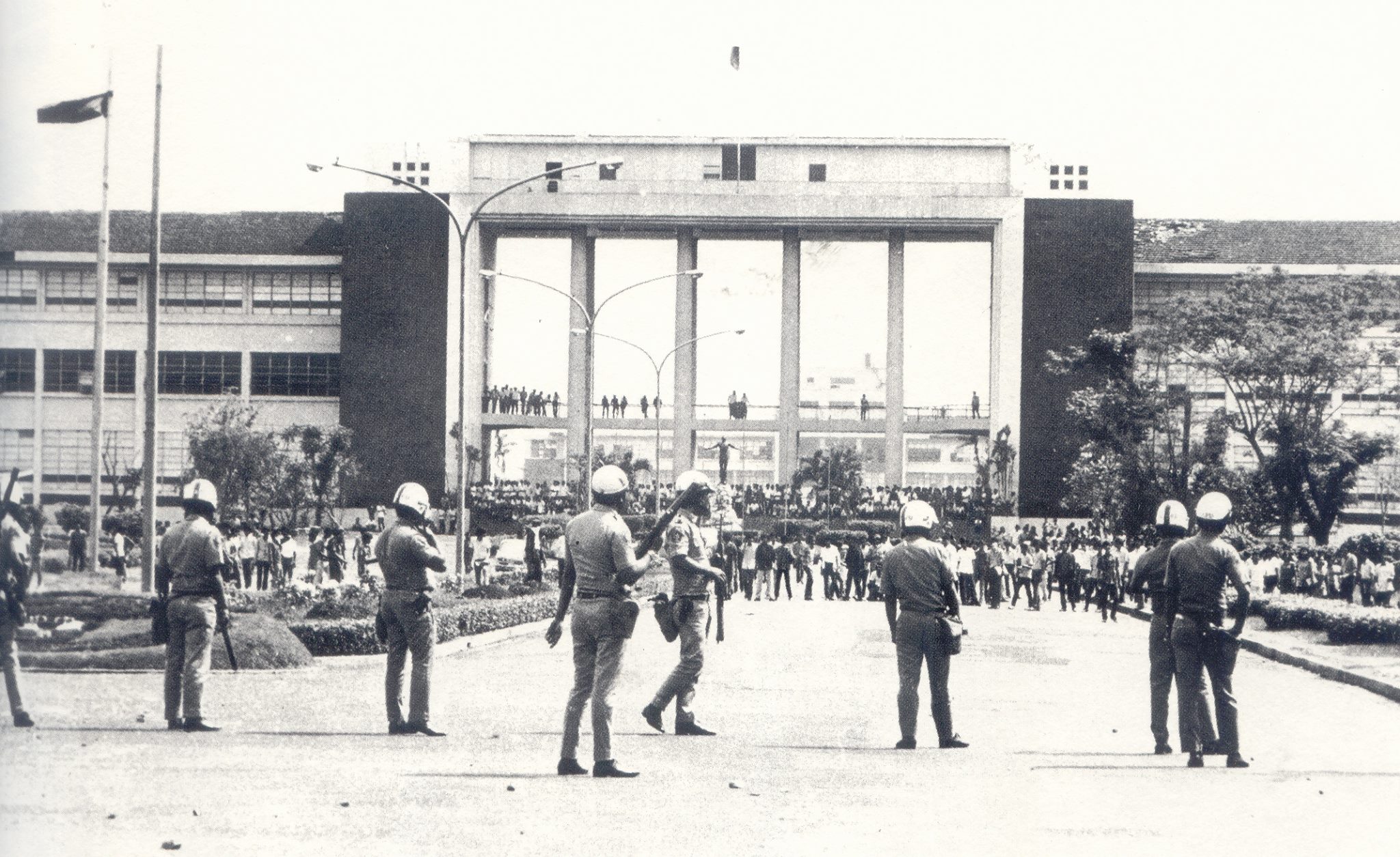
Fifty years ago from February 1 to 9, 1971, students and faculty of the University of the Philippines built barricades around the campus, in response to the three-centavo increase in oil prices in the Philippines. But it was more than just about oil prices. It was the culmination of years of unrest due to social inequities happening around the country and also a response to Ferdinand Marcos’ looming lust for power and his witch-hunting for communists. The event is now known as the Diliman Commune.
‘Raise High the Barricades!’
It was the rallying call of the Philippine Collegian, the student publication of UP, on February 4, 1971. Days prior to this editorial, various universities in Manila called for the erection of barricades around their campuses to show their support for striking jeepney drivers. UP was among the schools that heeded the call to erect barricades.
The peaceful assembly turned bloody when a UP Mathematics professor named Inocente Campos tried to disperse the students and shot Pastor “Sonny” Mesina Jr. This enraged the students, resulting in a massive walkout from their classes to join the barricades.
Fifty years ago from February 1 to 9, 1971, students and faculty of the University of the Philippines built barricades around the campus, in response to the three-centavo increase in oil prices in the Philippines. But it was more than just about oil prices. It was the culmination of years of unrest due to social inequities happening around the country and also a response to Ferdinand Marcos’ looming lust for power and his witch-hunting for communists. The event is now known as the Diliman Commune.
‘Raise High the Barricades!’
It was the rallying call of the Philippine Collegian, the student publication of UP, on February 4, 1971. Days prior to this editorial, various universities in Manila called for the erection of barricades around their campuses to show their support for striking jeepney drivers. UP was among the schools that heeded the call to erect barricades.
The peaceful assembly turned bloody when a UP Mathematics professor named Inocente Campos tried to disperse the students and shot Pastor “Sonny” Mesina Jr. This enraged the students, resulting in a massive walkout from their classes to join the barricades. ADVERTISEMENT – CONTINUE READING BELOW
The University of the Philippines described the details of what happened:
“As he (Campos) entered the first checkpoint on University Avenue, he slowed down but was not blocked by human barricades. Someone recognized him and soon pillboxes were thrown in the direction of his car. He continued driving but since a tire had been damaged, the car stopped. As students started advancing towards him, he went out of the car, put on a vest, got his shotgun from the back seat, and tried to fire to scare the students, but the gun was jammed and did not go off. He then got his .22 caliber rifle and started firing it, then drew his revolver and fired some more.
As a result of the Campos incident, a student, Pastor Mesina, Jr. was seriously wounded. He was taken to the UP Infirmary and later transferred to the Veterans’ Memorial Hospital. He died four days later.”
As events escalated, the Philippine Constabulary decided to intervene. They used sticks, shields, and guns to disperse the students. It was useless, as members of the faculty joined the barricade to protect their students. Professors and students raised their barricades even higher by hauling tables and chairs from their classrooms. Improvised Molotov cocktails, pillboxes, and rockets were also used to deter police from entering the University.
Raid on Sampaguita Residence Halls
The following day, on February 2, the police swiftly raided Sampaguita Residence Halls, a UP dormitory for women, after hearing reports that some of the barricaders were hiding there for refuge. It was a violent event, with defenseless students being arrested without warrants.
According to the Collegian, dozens of students were wounded during the raids, with at least 60 suffering injuries.
More than just a protest against rising oil prices
Days following the violence, it became clear the barricades were not merely a fight for the survival of jeepney drivers, but a fight for academic freedom and the right of peaceful assembly.
Realizing this, students and faculty through the radio broadcasts declared UP as a liberated area from state forces. They took over the campus radio station DZUP and the UP Press to make known their demands. They also renamed the school “Malayang Komunidad ng UP Diliman” (“Free Commune of UP Diliman”).
Fifty years ago from February 1 to 9, 1971, students and faculty of the University of the Philippines built barricades around the campus, in response to the three-centavo increase in oil prices in the Philippines. But it was more than just about oil prices. It was the culmination of years of unrest due to social inequities happening around the country and also a response to Ferdinand Marcos’ looming lust for power and his witch-hunting for communists. The event is now known as the Diliman Commune.
‘Raise High the Barricades!’
It was the rallying call of the Philippine Collegian, the student publication of UP, on February 4, 1971. Days prior to this editorial, various universities in Manila called for the erection of barricades around their campuses to show their support for striking jeepney drivers. UP was among the schools that heeded the call to erect barricades.
The peaceful assembly turned bloody when a UP Mathematics professor named Inocente Campos tried to disperse the students and shot Pastor “Sonny” Mesina Jr. This enraged the students, resulting in a massive walkout from their classes to join the barricades. ADVERTISEMENT – CONTINUE READING BELOW
The University of the Philippines described the details of what happened:
“As he (Campos) entered the first checkpoint on University Avenue, he slowed down but was not blocked by human barricades. Someone recognized him and soon pillboxes were thrown in the direction of his car. He continued driving but since a tire had been damaged, the car stopped. As students started advancing towards him, he went out of the car, put on a vest, got his shotgun from the back seat, and tried to fire to scare the students, but the gun was jammed and did not go off. He then got his .22 caliber rifle and started firing it, then drew his revolver and fired some more. CONTINUE READING BELOW Recommended Videos
As a result of the Campos incident, a student, Pastor Mesina, Jr. was seriously wounded. He was taken to the UP Infirmary and later transferred to the Veterans’ Memorial Hospital. He died four days later.” ADVERTISEMENT – CONTINUE READING BELOW
As events escalated, the Philippine Constabulary decided to intervene. They used sticks, shields, and guns to disperse the students. It was useless, as members of the faculty joined the barricade to protect their students. Professors and students raised their barricades even higher by hauling tables and chairs from their classrooms. Improvised Molotov cocktails, pillboxes, and rockets were also used to deter police from entering the University.
Police Officers Prepare to Face Off with UP Faculty and Students in 1971

ADVERTISEMENT – CONTINUE READING BELOW
Raid on Sampaguita Residence Halls
The following day, on February 2, the police swiftly raided Sampaguita Residence Halls, a UP dormitory for women, after hearing reports that some of the barricaders were hiding there for refuge. It was a violent event, with defenseless students being arrested without warrants.
According to the Collegian, dozens of students were wounded during the raids, with at least 60 suffering injuries.
More than just a protest against rising oil prices
Days following the violence, it became clear the barricades were not merely a fight for the survival of jeepney drivers, but a fight for academic freedom and the right of peaceful assembly.
Realizing this, students and faculty through the radio broadcasts declared UP as a liberated area from state forces. They took over the campus radio station DZUP and the UP Press to make known their demands. They also renamed the school “Malayang Komunidad ng UP Diliman” (“Free Commune of UP Diliman”). ADVERTISEMENT – CONTINUE READING BELOW https://4a323ff20d96ed7bc8968d61ae76a75d.safeframe.googlesyndication.com/safeframe/1-0-37/html/container.html
It was through the university radio and press that the name Diliman Commune came to be known. It was inspired by the Paris Commune of 1871, a socialist-led insurrection of Paris against the despotic French government from March 18 to May 28, 1871. That year was the 100th anniversary of the Paris Commune.
A year after the Diliman Commune, Marcos declared martial law.
Barricades Recreated
Visual artist Toym Imao recreated UP’s barricades in commemoration of the 50th anniversary of the Diliman Commune. The materials used for the sculptures are made from repurposed materials and condemned furniture. (PA)